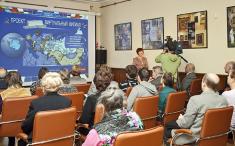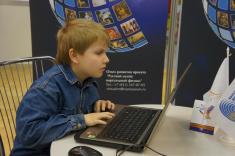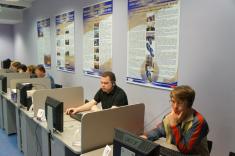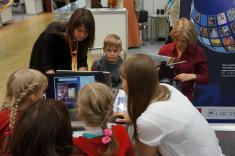«The Russian museum: the Virtual Branch" is an interregional and international project that embodies the idea of accessibility to the largest collection of Russian art for a wider audience outside St.Petersburg.
|
Among the main advantages of the project are accessibility for a wider audience to the enormous cultural heritage of Russia and the scientific potential of one of the largest museums in the world, as well as mobility of getting information and the possibility to overcome borders between countries and to establish friendly relations with neighbours on the basis of developing cultural and scientific contacts. Having started in 2003 in Nizhniy Novgorod as interregional, the project "The Russian Museum: the Virtual Branch" has become at the moment a large-scale international project and its geography has been constantly widening. Northwest and Central Russia have actively entered in the project. The idea of creating information and educational centres has been supported by Siberia, the Urals and the Far East. Neighbouring countries were the first to assess the significance of the project and join the community of virtual branches. At present information and educational centres are open in Azerbaijan, Belarus,Kazakhstan,Moldova, Lithuania,Estonia, Ukraine, Kyrgyzstan as well as Belgium, Greece, Italy, Spain, Germany. GreatBritain, Hungary, Romania, Slovenia, Finland, China, Chili and Cuba. Two virtual branches are open on Russian polar stations "Bellinsghausen"and "Novolazarevskaya" in Antarctica. |
|
The government of St. Petersburg and UNESCO office in Moscow for Azerbaijan, Armenia,Belarus, Moldova and Russian Federation have been taking part in realisation of the project since 2006. Under the support of the government of St. Petersburg and St. Petersburg Business Contact Centre "Bizkon" the opening of the information and educational centre in the Intercultural centre "MYLLY" in Kotka, Finland took place in 2007. In 2008 under the aegis of the government of St. Petersburg and the Committee for external relations the information and educational centre in Baku (Azerbaijan) was created, as well as the centres in Sevastopol and Zaporozhye (Ukraine) were opened. Realisation of the project is not limited only to the opening stage. On the contrary, an attraction of the project is that it consists of a long-term programme. It can be developed and realised gradually from a small start to a level determined by the people who are responsible for the project. |

 |

The project "The Russian Museum: the Virtual Branch" includes:
![]() Creation of the corporate network of the virtual branches uniting participants of the project "The Russian Museum: the Virtual Branch".
Creation of the corporate network of the virtual branches uniting participants of the project "The Russian Museum: the Virtual Branch".
The network enables participants to
- see live events going on in the Russian Museum (opening of exhibitions, lectures, discussions etc)
- exchange news
- get access to new multimedia programs being developed by the Russian Museum and other participants of the project
- take part in distance learning
![]() Video conferences between the Russian Museum and the virtual branches of the museum.
Video conferences between the Russian Museum and the virtual branches of the museum.
![]() Participation in design and analytical as well as scientific and methodological seminars, contests of multimedia, virtual exhibitions and so on.
Participation in design and analytical as well as scientific and methodological seminars, contests of multimedia, virtual exhibitions and so on.
 |
 |
 |
Democracy, accessibility, mobility and most of all rich contents determine a wide range of participants. These are museums, universities, institutes, art schools, navy and military schools, centres of information technologies and children's creative work, gymnasiums, medical centers of rehabilitation, libraries, Centres of Russian Culture abroad.
Main forms of activities of the virtual branches:
- Virtual tours around the rooms and palaces of the Russian Museum, lectures and conferences on art, culture and the history of Russia
- Thematic classes for teachers, students, schoolchildren, and other visitors
- Use of the Mediateka's resources for the preparation of reports, course and diploma papers
- Organisation of training courses for students, advanced training courses for teachers and museum staff
- on site classes in schools, museums, libraries and so on.
- distance learning on the history of art for art history teachers
- organisation of art lovers, guides, lecturers' study groups as well as clubs (family, students, weekend)
- art exhibitions, workshops, and meetings with artists
- Contests and celebrations.




